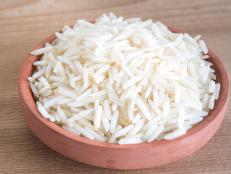Stop Avoiding White Foods in the Name of Health
"Eating the rainbow" includes pasta and potatoes.

elenaleonova/Getty Images
Have you ever heard the term "eat the rainbow" in the name of health and then proceeded to avoid all white foods from then on? The idea that color equals nutrition in food and that white food is "bad" is a myth that’s been swirling around the Internet that drives many dietitians insane. From potatoes to pasta to milk to all-purpose flour – there are lots of white foods that folks avoid putting on their plates because they believe they're unhealthy. Here's why you should be embracing white foods as part of a healthy eating plan.
Are White Foods “Bad?”
Categorizing foods as “good” or “bad” is extreme. There is truly no “bad” food — it’s really about how you incorporate the food into your healthy eating plan. Clearly granulated sugar isn’t the most nutritious choice, but that doesn't mean you need to avoid sugar 100% of the time. The 2020-2025 dietary guidelines for Americans set a maximum daily limit of 10% of total daily calories from added sugar. It doesn’t say to consume zero added sugar. Interestingly, it says that it’s pretty tough to have less than 2% of your daily total calories from added sugar.
Instead of nixing a food completely from your diet, think about how it should be used. A food like granulated sugar can be used in small amount to add sweetness to nutrient-dense foods like oatmeal or to help balance the acidity in a tomato-based sauce.
What About Other “White” Foods?
If you've been avoiding all white foods including fresh produce, it's time to recalibrate your healthy eating plan. Here’s a rundown on five other white foods that are healthier than you may think and can fit into your healthy eating plan.
- Potatoes: One medium (skin-on) spud provides 110 calories and 30% of your daily recommended amount of vitamin C, plus carbs and potassium. Research shows that foods high in potassium and low in sodium – like potatoes – may reduce the risk of high blood pressure and stroke.
- Pasta: Enriched wheat pasta tends to be eaten in very large portions by many, so it has gotten a bad reputation. Instead of having a plate of pasta topped with tomato sauce, add pieces of chicken breast, chickpeas or beans and cooked vegetables like broccoli, zucchini, spinach, or kale. You'll decrease the amount of pasta and increase other nutrients to make it a balanced meal. In addition, enriched wheat pasta is enriched with many B-vitamins so it provides nutrients. If you want to get the fiber, then opt for whole grain pasta or legume-based pasta.
- All-Purpose (AP) Flour: Flour certainly has its time and place. Look for an enriched variety which provides a range of nutrients that Americans may be missing. You want to use it in small amounts – like in breading, thickening sauces, or you can combine it 50:50 ratio with whole wheat flour in baking recipes.
- Bananas: This easy to grab-and-go snack are full of nutrition. One medium yellow banana provides 109 calories and is an excellent source of vitamin B6, and a good source of potassium, fiber, and vitamin C. All these nutrients are associated with heart health and fiber and potassium are identified by the 2020-2025 dietary guidelines as under consumed nutrients for Americans. Plus, you’ll be missing out on the deliciousness that bananas offer in bread, muffin, pancakes, and much more!
- Milk: One serving of milk provides 13 essential nutrients that your body needs including three nutrients under consumed by Americans, potassium, calcium, and vitamin D. Milk also provides nutrients that help keep your immune system healthy including protein, selenium, zinc, and vitamin D.
Bottom Line: All foods can fit into a healthy eating plan it’s just about how you use them in your meal or snack.
Toby Amidor, MS, RD, CDN, is a registered dietitian and consultant who specializes in food safety and culinary nutrition. She is the author of The Greek Yogurt Kitchen: More Than 130 Delicious, Healthy Recipes for Every Meal of the Day.
*This article was written and/or reviewed by an independent registered dietitian nutritionist.
Related Links:


































